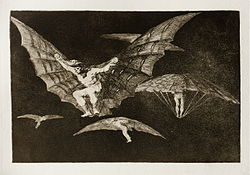

Los disparates (The Follies), also known as Proverbios (Proverbs) or Sueños (Dreams), is a series of prints in etching and aquatint, with retouching in drypoint and engraving, created by Spanish painter and printmaker Francisco Goya between 1815 and 1823. Goya created the series while he lived in his house near Manzanares (Quinta del Sordo) on the walls of which he painted the famous Black Paintings. When he left to France and moved in Bordeaux in 1824, he left these works in Madrid apparently incomplete. During Goya's lifetime, the series was not published because of the oppressive political climate and of the Inquisition.
The disparates series was first published by the Royal Academy of Fine Arts of San Fernando in 1864 under the title Proverbios[2] (Proverbs). In this edition, the titles given to the works are Spanish proverbs. The series is an enigmatic album of twenty-two prints (originally eighteen; four works were added later) which is the last major series of prints by Goya, which the artist created during the last years of his life. The scenes of the Disparates, which are difficult to explain, include dark, dream-like scenes that scholars have related to political issues, traditional proverbs and the Spanish carnival.[3]
- ^ Hughes, (1990), 63
- ^ Ives, Colta Feller & Susan Alyson Stein (en inglés): Goya in the Metropolitan Museum of Art, pp. 26-8. Metropolitan Museum of Art (New York, N.Y.) 1995. Metropolitan Museum of Art. Retrieved 7 May 2017.
- ^ The University of Arizona Museum of Art